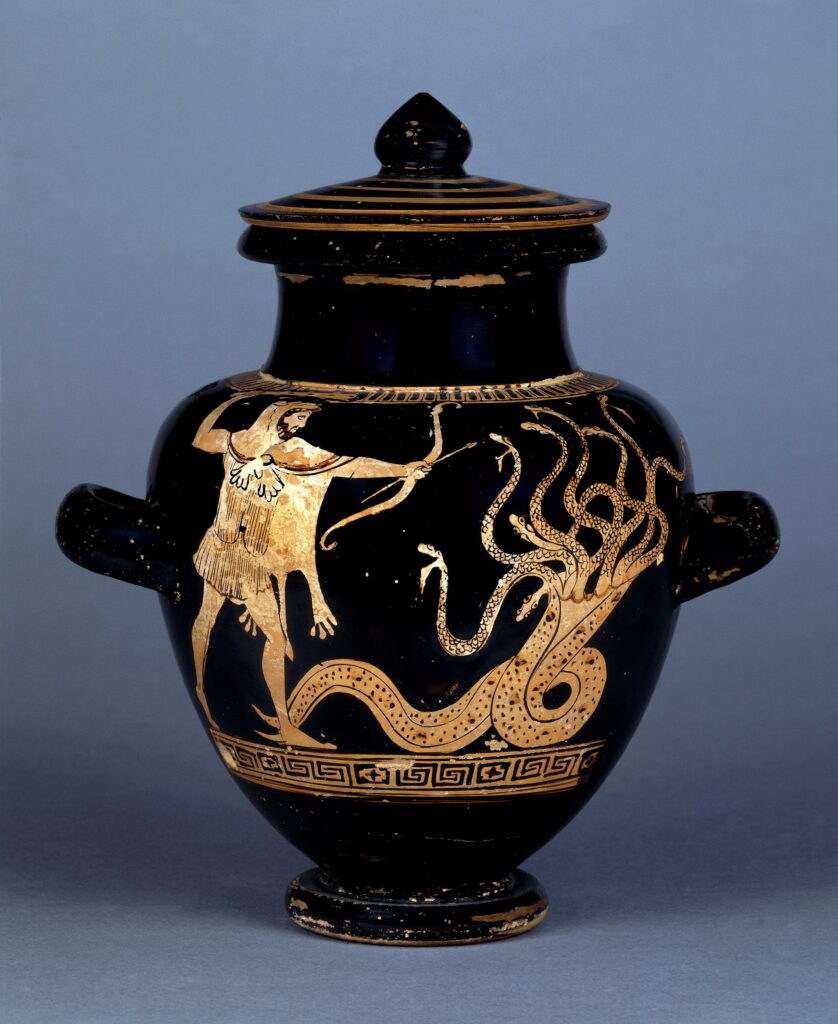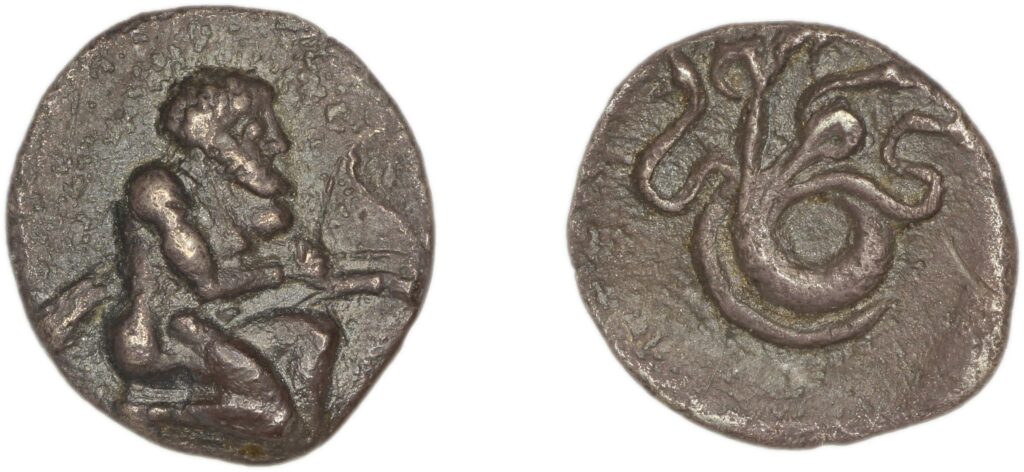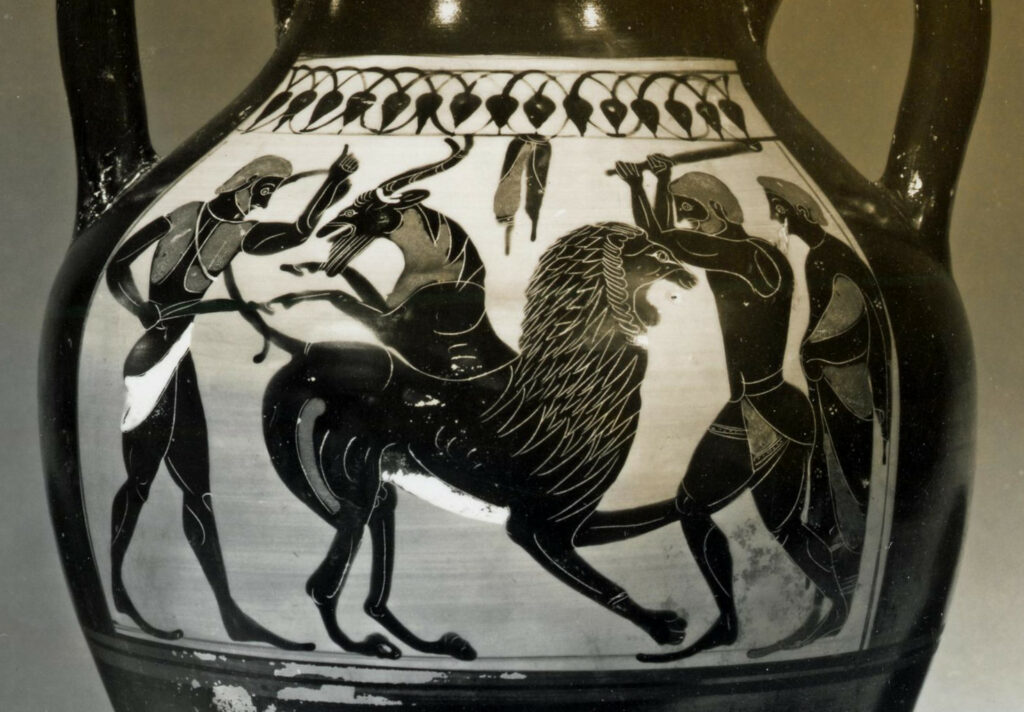There are many references to monsters in ancient Greek texts, some with detailed descriptions. This Gallery illustrates how just three of them were depicted in the visual arts: Scylla, the Hydra, and the Chimera.
Scylla
When Circe warns Odysseus that his journey must take him past the dangers posed by Scylla, who lives up in a sheer cliff face, she provides a vivid description of what he will face:
… the cave is so high up that not even the stoutest archer could send an arrow into it. [85] Inside it Scylla sits and yelps with a voice that you might take to be that of a young hound, but in truth she is a dreadful monster and no one—not even a god—could face her without being terror-struck. She has twelve misshapen feet, and six [90] necks of the most prodigious length; and at the end of each neck she has a frightful head with three rows of teeth in each, all set very close together, so that they would crunch anyone to death in a moment, [95] and she sits deep within her shady cell thrusting out her heads and peering all round the rock, fishing for dolphins or dogfish or any larger monster that she can catch, of the thousands with which Amphitrite teems. No ship ever yet got past her without losing some men, for she shoots out all her heads at once, [100] and carries off a man in each mouth.
Odyssey 12.83–100, Sourcebook[1]
All six heads must have been in action when Odysseus sails past, because he loses exactly that many men:
[245] Scylla pounced down suddenly upon us and with violence [biē] snatched up my six best men. I was looking at once after both ship and men, and in a moment I saw their hands and feet ever so high above me, struggling in the air as Scylla was carrying them off
Odyssey 12.245–249, Sourcebook[2]
Perhaps her appearance was too complex to depict the same way in artworks: they mainly show her with coiled tails rather than twelve feet, no more than four dog’s heads at the waist (with teeth indeterminate), and a single humanoid head: terrifying enough, though! Curiously there are a number of coins which feature an image of Scylla.




Scylla, Relief plaque c. 450 BCE © The Trustees of the British Museum
Pottery pilgrim-flask 3rd century BCE – 2nd century BCE, Italy © The Trustees of the British MuseumAlthough he approaches fully armed, Odysseus does not attempt to fight or kill Scylla. Other monsters fare less well at the hands of the heroes. The Hydra is one such example.
The Hydra
Apollodorus’ account of the Labors of Herakles describes the Hydra:
As a second labour he [=Eurystheus] ordered him [=Herakles] to kill the Lernaean hydra. That creature, bred in the swamp of Lerna, used to go forth into the plain and ravage both the cattle and the country. Now the hydra had a huge body, with nine heads, eight mortal, but the middle one immortal. So mounting a chariot driven by Iolaus, he came to Lerna, and having halted his horses, he discovered the hydra on a hill beside the springs of the Amymone, where was its den. By pelting it with fiery shafts he forced it to come out, and in the act of doing so he seized and held it fast. But the hydra wound itself about one of his feet and clung to him. Nor could he effect anything by smashing its heads with his club, for as fast as one head was smashed there grew up two. A huge crab also came to the help of the hydra by biting his foot. So he killed it, and in his turn called for help on Iolaus who, by setting fire to a piece of the neighboring wood and burning the roots of the heads with the brands, prevented them from sprouting. Having thus got the better of the sprouting heads, he chopped off the immortal head, and buried it, and put a heavy rock on it
Apollodorus Library 2.5.2, translated by Frazer[3]

Herakles slaying the Lernaean Hydra. Marble relief, 3rd century BCE
Diosophos Painter. Heracles, Iolaus, and the Lemaean Hydra. Lekythos c. 500–475 BCE
Herakles and Iolaos slaying the hydra. Illustration, presumably based on an original vase painting, 1843
Manner of the Princeton Painter, Herakles and Iolaus fighting the Lernaean Hydra. Amphora, c 540 – 530 BCE
Fragmentary jar with scene of Herakles slaying the Hydra of Lerna, South Italy, 375–340 BCE
Geras Painter (attributed) Herakles and the Lernian Hydra, red-figured stamnos, c. 480 BCE–470 BCE© The Trustees of the British Museum
Coin: Herakles (obverse), The Lernean Hydra (reverse). 400–344 BCE © The Trustees of the British MuseumFor once, Herakles has an assistant when facing that challenge. Bellerophon, however, has to kill the Chimera alone—although attacking while mounted on a winged horse, Pegasus, perhaps more than makes up for it.
Chimera
There are fairly consistent descriptions of this composite monster.
But she [Echidna] bore Chimaera, breathing resistless fire, 320 fierce and huge, fleet-footed as well as strong; this monster had three heads: one indeed of a grim-visaged lion, one of a goat, and another of a serpent, a fierce dragon; in front a lion, a dragon behind, and in the midst a goat; breathing forth the dread strength of burning fire. 325 Pegasus, with brave Bellerophon, slew her.
Hesiod Theogony 319–325, Sourcebook[4]
The account in the Iliad describes her as a goddess. Glaukos recounts how the king of Lycia…
…first commanded Bellerophon to kill that savage monster, the Chimaera, [180] who was not a human being, but a goddess, for she had the head of a lion and the tail of a serpent, while her body was that of a goat, and she breathed forth flames of fire; but Bellerophon slew her, for he was guided by divine signs.
Iliad 6.179–183, Sourcebook[5]
Apollodorus provides a similar account, but emphasizes the creature’s strength:
Iobates ordered him [=Bellerophon] to kill the Chimera, believing that he would be destroyed by the beast, for it was more than a match for many, let alone one; it had the fore part of a lion, the tail of a dragon, and its third head, the middle one, was that of a goat, through which it belched fire. And it devastated the country and harried the cattle; for it was a single creature with the power of three beasts.
Apollodorus Library 2.3, translated by Frazer[6]
Some of the artworks emphasize the monster, while others depict Bellerophon and Pegasus as the main focus. One of the images is on an epinetron, which apparently would have been worn by a woman to protect her thighs when weaving, which suggests to me that these themes would have been found in all sorts of settings. And surprisingly the Chimera appears on an Egyptian scarab, the earliest in date of all these images. Another surprise is a vase painting that shows a different version of the slaying of the Chimera: the curator’s notes say:
There is no trace of any myth connecting Heracles with the Chimaera; but the characteristics of the two figures are those of Heracles and Iolaos; and Bellerophon is always represented youthful and with a spear. The vase-painter may have confused two myths, or possibly the scene may have no mythological signification.[7]

Attributed to Boreads Painter: Pegasus, Bellerophon and Chimera. Lakonian Black-Figure Kylix; detached fragments; 570–565 BCE
Chimera Painter: Chimera. Corinthian ceramic c. 570–500 BCE
Bellerophon and Chimera. Terracotta flask, c. 300–250 BCE © The Trustees of the British Museum
Chimera on amphora, c. 550–525 BCE
Bellerophon and the Chimera, edge of an Attic red-figure epinetron (thigh-protector used by a woman when weaving), c. 425–420 BCE
Heidelberg Painter: Bellerophon fighting the Chimera. Side A of an Attic black-figured “overlap” Siana cup, c. 575–550 BCE
Intaglio, 1st–3rd century CE. © The Trustees of the British Museum

Bellerophon and Chimera: Coin from Roman Republic

Attributed to The Swing Painter: Chimera with possibly Herakles and Iolaus. Black-figured amphora, c. 540–520 BCE © The Trustees of the British Museum
Other monsters
There are many other monsters mentioned in the ancient Greek (and Roman) myths. Which is your favorite? In the forum, please share a quotation with its description, and an image from ancient times if you can find one! Are they consistent with each other?
Related topics
Open House | Monster Menageries of Homer and Hesiod, with Yiannis Petropoulos
Open House | Mothers of Heroes and Monsters: Althaea and Callirhoe, with Maria G. Xanthou
The Idealized Ship | Part 2: Huge, hollow and swallowing
Notes
1 Sourcebook Homeric Odyssey. translated by Samuel Butler, revised by Timothy Power, Gregory Nagy, Soo-Young Kim, and Kelly McCray.
Online at Kosmos Society
2 Sourcebook Homeric Odyssey. translated by Samuel Butler, revised by Timothy Power, Gregory Nagy, Soo-Young Kim, and Kelly McCray.
Online at Kosmos Society
3 Apollodorus, The Library, with an English Translation by Sir James George Frazer, F.B.A., F.R.S. in 2 Volumes. Cambridge, MA, Harvard University Press; London, William Heinemann Ltd. 1921.
Online at Perseus
4 Sourcebook Hesiodic Theogony. 1–115: Translated by Gregory Nagy, 116–1022: Translated by J. Banks, adapted by Gregory Nagy
Online at Kosmos Society
5 Sourcebook Homeric Iliad Translated by Samuel Butler, revised by Soo-Young Kim, Kelly McCray, Gregory Nagy, and Timothy Power
Online at Kosmos Society
6 Apollodorus, The Library, with an English Translation by Sir James George Frazer, F.B.A., F.R.S. in 2 Volumes. Cambridge, MA, Harvard University Press; London, William Heinemann Ltd. 1921.
Online at Perseus
7 Curator’s comments to Museum number 1843,1103.64, The British Museum website
https://www.britishmuseum.org/collection/object/G_1843-1103-64
Texts retrieved April 2024.
Image credits
Scylla
Scylla figurine, late 4th century BCE
Photo: Gre regiment. Creative Commons Attribution-Share Alike 4.0 International license, via Wikimedia Commons
Scylla. Detail from side A from a Boeotian red-figure bell-crater, 450–425 BCE
Photo: Jastrow. Public domain, via Wikimedia Commons
Coin, 42 – 40 BCE, Sicily. Reverse: “Scylla, wielding rudder with both hands”
Creative Commons Attribution-NonCommercial-ShareAlike 4.0 International (CC BY-NC-SA 4.0) license
© The Trustees of the British Museum
Silver coin, c. 390BCE–340BCE, Heraclea. Obverse, “Head of Athena, right, wearing Attic helmet decorated with Scylla holding octopus.”
Creative Commons Attribution-NonCommercial-ShareAlike 4.0 International (CC BY-NC-SA 4.0) license
© The Trustees of the British Museum
Relief plaque Scylla, c 450 BCE
Creative Commons Attribution-NonCommercial-ShareAlike 4.0 International (CC BY-NC-SA 4.0) license
© The Trustees of the British Museum
Pottery pilgrim-flask 3rd century BCE – 2nd century BCE, Italy
Creative Commons Attribution-NonCommercial-ShareAlike 4.0 International (CC BY-NC-SA 4.0) license
© The Trustees of the British Museum
Lamian Hydra
Heracles and the Lemaean Hydra. Hydria, 520–510 BCE
Photo: Wolfgang Sauber (User:Xenophon).Creative Commons Attribution-Share Alike 3.0 Unported, 2.5 Generic, 2.0 Generic and 1.0 Generic license.
Hercules slaying the Lernaean Hydra. Marble relief, 3rd century BCE
Photo: George E. Koronaios. Creative Commons Attribution-Share Alike 4.0 International license, via Wikimedia Commons.
Diosophos Painter. Heracles, Iolaus, and the Lernaean Hydra. Lekythos c 500–475 BCE
Photo: Bibi Saint-Pol, public domain, via Wikimedia Commons
Herakles and Iolaos slaying the hydra. Illustration, presumably based on an original vase painting, 1843
Eduard Gerhard. Public domain, via Wikimedia Commons
Manner of the Princeton Painter, Heracles and Iolaus fighting the Lernaean Hydra. Amphora, c 540 – 530 BCE
Louvre, Public domain, via Wikimedia Commons
Fragmentary jar with scene of Herakles slaying the Hydra of Lerna, South Italy, 375–340 BCE
Photo: Daderot. Creative Commons CC0 1.0 Universal Public Domain Dedication, via Wikimedia Commons
Geras Painter (attributed) Herakles and the Lernian Hydra, red-figured stamnos, c. 480 BCE–470 BCE
Creative Commons Attribution-NonCommercial-ShareAlike 4.0 International (CC BY-NC-SA 4.0) license
© The Trustees of the British Museum
Coin: Herakles (obverse), The Lernean Hydra (reverse). 400BCE–344BCE
Creative Commons Attribution-NonCommercial-ShareAlike 4.0 International (CC BY-NC-SA 4.0) license
© The Trustees of the British Museum
Chimera
Chimera. Apulian red-figure dish, c. 350–340 BCE
Photo: Jastrow. Public domain, via Wikimedia Commons
Attributed to Boreads Painter: Lakonian Black-Figure Kylix; detached fragments; 570-565 BCE
Public domain, via Wikimedia Commons
Chimera Painter: Corinthian ceramic c. 570–500- BCE
Photo: Sailko. Creative Commons Attribution-Share Alike 3.0 Unported license, via Wikimedia Commons
Terracotta flask, c. 300–250 BCE
Creative Commons Attribution-NonCommercial-ShareAlike 4.0 International (CC BY-NC-SA 4.0) license
© The Trustees of the British Museum
Chimera on amphora, c. 550–525 BCE
Photo: Sailko. Creative Commons Attribution 3.0 Unported license, via Wikimedia Commons
Bellerophon and the Chimera, edge of an Attic red-figure epinetron (thigh-protector used by a woman when weaving), c. 425–420 BCE
Photo: Marsyas. Creative Commons Attribution-Share Alike 2.5 Generic license, via Wikimedia Commons
Heidelberg Painter: Bellerophon fighting the Chimera. Side A of an attic black-figured “overlap” Siana cup, c. 575–550 BCE
Photo: Bibi Saint-Pol/ Public domain, via Wikimedia Commons
Intaglio, “glass paste imitating amethyst”, 1st–3rd century CE
Creative Commons Attribution-NonCommercial-ShareAlike 4.0 International (CC BY-NC-SA 4.0) license
© The Trustees of the British Museum
Silver coin, c. 395–390 BCE, Campania
Creative Commons Attribution-NonCommercial-ShareAlike 4.0 International (CC BY-NC-SA 4.0) license
© The Trustees of the British Museum
Coin from Roman Republic (undated)
Photo: Sailko. Creative Commons Attribution-Share Alike 3.0 Unported license, via Wikimedia Commons
Scarab, blue paste, 600 – 570 BCE
Creative Commons Attribution-NonCommercial-ShareAlike 4.0 International (CC BY-NC-SA 4.0) license
© The Trustees of the British Museum
Attributed to The Swing Painter: Black-figured amphora, c. 540–520 BCE
Creative Commons Attribution-NonCommercial-ShareAlike 4.0 International (CC BY-NC-SA 4.0) license
© The Trustees of the British Museum
Note: Images have been selected from pictures that are freely available with open source or Creative Commons licenses or from photographs sent in by community members for the purpose. Attributions are based where possible by those shown by galleries or museums, or on Wikimedia Commons or Flickr at the time of publication on this website.
Images retrieved April 2024.
___
Sarah Scott is a member of Kosmos Society.




